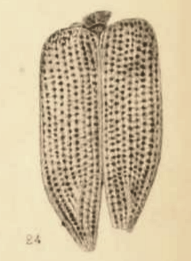|
2003 In Paleontology
Plants Conifers Angiosperms Gnetophytes Fungi Arthropods Arachnids Insects Conodont paleozoology German paleontologist and stratigraphy, stratigrapher Heinz Walter Kozur (1942-2013) described the conodont genus ''Carnepigondolella''. Vertebrate paleozoology Parareptiles Non-avian dinosaurs Data courtesy of George Olshevsky's dinosaur genera list. Newly named birds Plesiosaurs Pterosaurs Synapsids Non-mammalian Mammals References {{portal, Paleontology [...More Info...] [...Related Items...] OR: [Wikipedia] [Google] [Baidu] |
Chamaecyparis Eureka
''Chamaecyparis eureka'' is an extinct species of conifer in the family Cupressaceae. It is known from fossil foliage found in the Buchanan Lake Formation deposits, dated to the middle Eocene Lutetian stage (), from western Axel Heiberg Island, located in the Arctic Ocean in the Qikiqtaaluk Region, Nunavut, Canada. ''C. eureka'' is the oldest confirmed member of the genus '' Chamaecyparis'', which includes five to six living species, depending on circumscription, which are native to Eastern Asia, Japan, and North America. Description of the new species by M. E. A. Kotyk, James Basinger, and Elisabeth McIver was based on the study of more than 850 twigs and 650 seed cone specimens; the holotype specimen, number "USPC-6357", and the five paratypes are housed in the University of Saskatchewan Paleobotanical Collection, Saskatoon, Saskatchewan, Canada. They published their 2003 type description of the species in the ''Canadian Journal of Botany'' volume number 81. and named the ... [...More Info...] [...Related Items...] OR: [Wikipedia] [Google] [Baidu] |
Corylus
The hazel (''Corylus'') is a genus of deciduous trees and large shrubs native to the temperate Northern Hemisphere. The genus is usually placed in the birch family Betulaceae,Germplasmgobills Information Network''Corylus''Rushforth, K. (1999). ''Trees of Britain and Europe''. Collins .Huxley, A., ed. (1992). ''New RHS Dictionary of Gardening''. Macmillan . though some botanists split the hazels (with the hornbeams and allied genera) into a separate family Corylaceae. The fruit of the hazel is the hazelnut. Hazels have simple, rounded leaves with double-serrate margins. The flowers are produced very early in spring before the leaves, and are monoecious, with single-sex catkins. The male catkins are pale yellow and long, and the female ones are very small and largely concealed in the buds, with only the bright-red, 1-to-3 mm-long styles visible. The fruits are nuts long and 1–2 cm diameter, surrounded by an involucre (husk) which partly to fully encloses the nut ... [...More Info...] [...Related Items...] OR: [Wikipedia] [Google] [Baidu] |
Green River Formation
The Green River Formation is an Eocene geologic formation that records the sedimentation in a group of intermountain lakes in three basins along the present-day Green River in Colorado, Wyoming, and Utah. The sediments are deposited in very fine layers, a dark layer during the growing season and a light-hue inorganic layer in the dry season. Each pair of layers is called a varve and represents one year. The sediments of the Green River Formation present a continuous record of six million years. The mean thickness of a varve here is 0.18 mm, with a minimum thickness of 0.014 mm and maximum of 9.8 mm.Bradley, W. H. The varves and climate of the Green River epoch: U.S. Geol. Survey Prof. Paper 158, pp 87–110, 1929. The sedimentary layers were formed in a large area named for the Green River, a tributary of the Colorado River. The three separate basins lie around the Uinta Mountains (north, east, and south) of northeastern Utah: * an area in northwestern Colorado east ... [...More Info...] [...Related Items...] OR: [Wikipedia] [Google] [Baidu] |
Allenby Formation
The Allenby formation is a sedimentary rock formation in British Columbia which was deposited during the Ypresian stage of the Early Eocene. It consists of conglomerates, sandstones with interbedded shales and coal. The shales contain an abundance of insect, fish and plant fossils known from 1877 and onward, while the Princeton Chert was first indented in the 1950's and is known from anatomically preserved plants. There are several notable fossil producing localities in the Princeton & Tulameen basins. Historical collection sites included Nine Mile Creek, Vermilian Bluffs, and Whipsaw Creek, while modern sites include One Mile Creek, Pleasant Valley, Thomas Ranch, and the Princeton Chert. Extent and correlation The Allenby is estimated to have an overall extent of approximately , though actual outcroppings of the formation make up less than 1% of the formation, while other exploratory contact is via boreholes and mines. The half-graben which contains the formation is s ... [...More Info...] [...Related Items...] OR: [Wikipedia] [Google] [Baidu] |
Coldwater Beds
The Coldwater Beds are a geologic formation of the Okanagan Highlands in British Columbia, Canada. They preserve fossils dating back to the Ypresian stage of the Eocene period, or Wasatchian in the NALMA classification.Coldwater Beds at Fossilworks.org The formation comprises mudstones, shales and s deposited in a |
David P
David (; , "beloved one") (traditional spelling), , ''Dāwūd''; grc-koi, Δαυΐδ, Dauíd; la, Davidus, David; gez , ዳዊት, ''Dawit''; xcl, Դաւիթ, ''Dawitʿ''; cu, Давíдъ, ''Davidŭ''; possibly meaning "beloved one". was, according to the Hebrew Bible, the third king of the United Kingdom of Israel. In the Books of Samuel, he is described as a young shepherd and harpist who gains fame by slaying Goliath, a champion of the Philistines, in southern Canaan. David becomes a favourite of Saul, the first king of Israel; he also forges a notably close friendship with Jonathan, a son of Saul. However, under the paranoia that David is seeking to usurp the throne, Saul attempts to kill David, forcing the latter to go into hiding and effectively operate as a fugitive for several years. After Saul and Jonathan are both killed in battle against the Philistines, a 30-year-old David is anointed king over all of Israel and Judah. Following his rise to power, David ... [...More Info...] [...Related Items...] OR: [Wikipedia] [Google] [Baidu] |




